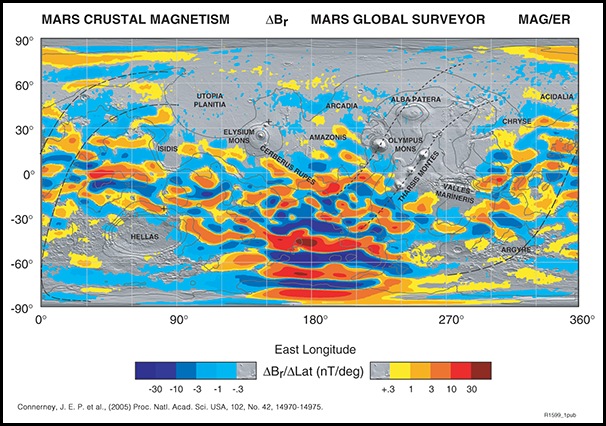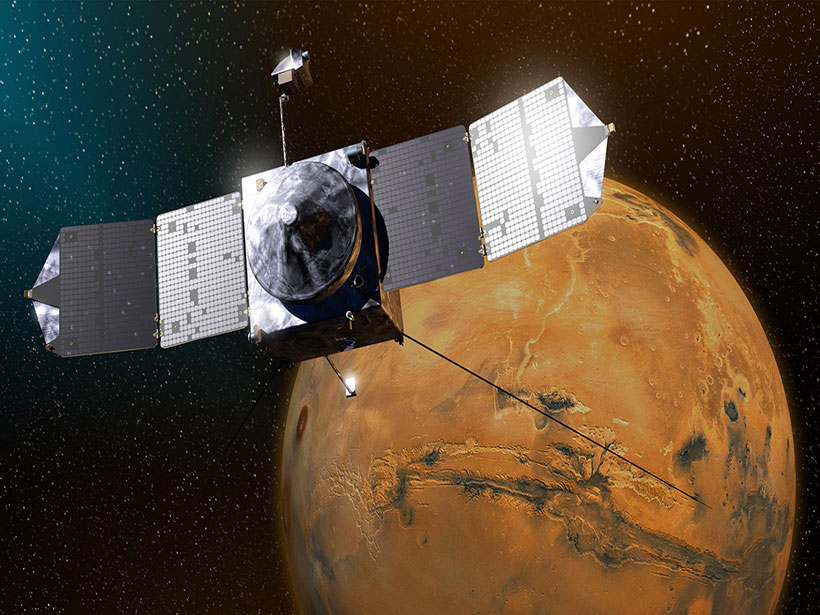Early Mars was much more similar to Earth than it is today. It had a thick atmosphere, liquid water at its surface, and a global magnetic field. But at some point, the magnetic field disappeared, and Mars turned into the barren desert we see today, although researchers haven’t entirely figured out the full sequence of how and why this happened.
Adding one more piece to the puzzle, a group of researchers has now found evidence showing that the Martian magnetic field was active for a much longer period than previously thought.
Mars’s Dying Dynamo
A planet’s magnetic field is generated by an internal dynamo in which liquid metal flowing within the planet’s outer core produces an electrical current. The magnetic field can be recorded on the planet’s surface by rocks containing magnetic minerals that align with the magnetic field when the rocks form. Volcanic rocks are particularly good at recording, and by dating them, scientists can determine whether the dynamo was active at the time the rocks were emplaced.
Researchers know that Mars had an active magnetic field between 4.3 and 4.2 billion years ago. But observations from NASA’s Mars Global Surveyor (which orbited the planet between 1999 and 2006) didn’t show any sign of magnetism over Hellas, Argyre, and Isidis, three large impact basins that formed about 3.9 billion years ago. This lack of evidence led most scientists to believe that the dynamo had already stopped by that time.

Now, looking at new observations from another NASA mission, the Mars Atmosphere and Volatile Evolution (MAVEN) satellite, scientist are reevaluating that idea. Anna Mittelholz, a geophysicist at the University of British Columbia in Vancouver, Canada, has found evidence showing that the Martian dynamo was active for at least 700 million years longer than previously thought.
Mittelholz and her colleagues detected low-intensity magnetic fields over one of the oldest features on Mars, the Borealis Basin. Located in the planet’s northern hemisphere, scientists think the basin was formed about 4.5 billion years ago. They also found evidence of a magnetic field coming from a lava flow in a region called Lucus Planum, with an age of 3.7 billion years.
Mittelholz spotted a 35-kilometer-wide impact crater piercing the lava flow. The magnetic signal picked up by MAVEN drops at the crater, indicating that the lava flow itself is magnetized, not any other material lying below it.
“There is this lava flow that has a magnetic signal, and it drops as we see a hole in the surface,” Mittelholz said. “I think this is the first time we can make a dating argument that is that solid.”
“This is the first time that I have seen evidence that the dynamo could have been active past 4 billion years ago,” said David Brain, a planetary scientist at the University of Colorado Boulder who wasn’t involved in the new study. “The evidence for 3.7 [billion years] for a young dynamo is based on the demagnetization signature of a single impact crater, so of course, I would love to see more such signatures at other places on Mars.”
Mittelholz and her colleagues published their findings in Science Advances in May.
A Magnetic Patchwork
Although some areas show stronger magnetism than others, the difference doesn’t necessarily mean that the global magnetic field was weaker at a certain time. It’s more likely a matter of the abundance of carrier minerals.
After the global magnetic field disappeared, Mars was left with a patchwork of magnetized rocks and minerals of varying intensities scattered around its surface.
Although some areas show stronger magnetism than others, the difference doesn’t necessarily mean that the global magnetic field was weaker at a certain time, Mittelholz said. It’s more likely a matter of the abundance of carrier minerals—those minerals in the rock that can be influenced by the planet’s magnetic field. Mittelholz attributes the low-intensity magnetic fields over the Borealis Basin to fewer carrier minerals in the rock formation. “In the northern hemisphere, we have generally weak fields, probably because the concentration of magnetic carriers is much lower,” she said.
A lower abundance of carrier minerals could also explain why the three large impact basins in the northern hemisphere lack signs of magnetism. Maybe, research suggests, the impacts that created the basins also removed large portions of the Martian crust and, with it, the minerals needed to record strong magnetism in the rock. “There might still be signatures within the basins that are not visible from high altitude,” Mittelholz said. “If the wavelength of the features is too small in extent or if it’s weak, we won’t be able to see it from orbit.”
Magnetism at a Crucial Time for Martian History
Although extending the active period of the Martian dynamo by 400 million years doesn’t sound like a lot when compared to the planet’s 4.6-billion-year life span, it was a very agitated period of Martian history.
“All the major impacts happened in that time: the Hellas basin, the Argyre basin, the Late Heavy Bombardment of the inner solar system occurred during that period, and a lot of the evidence for liquid water on the surface of Mars is right around this time,” Brain said. “Knowing that the interior was generating enough energy to support a dynamo I think is important.”
A longer-lived magnetic field could have also made Mars a friendlier place for life. The magnetic field could have slowed down the process of atmospheric escape, although scientists are still debating if that could be the case. What’s clear is that much less radiation would have reached the surface of the planet. “A magnetic field can protect the surface of a planet from charged-particle radiation that would strike the surface and be bad for any life near the surface,” Brain said. “If you can extend that protected period for longer, then, maybe, that has implications [for life].”
—Javier Barbuzano (@javibarbuzano), Science Writer
Citation:
Barbuzano, J. (2020), A longer-lived magnetic field for Mars, Eos, 101, https://doi.org/10.1029/2020EO144726. Published on 01 June 2020.
Text © 2020. The authors. CC BY-NC-ND 3.0
Except where otherwise noted, images are subject to copyright. Any reuse without express permission from the copyright owner is prohibited.

